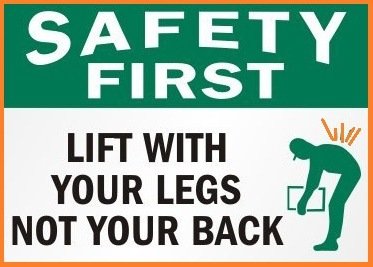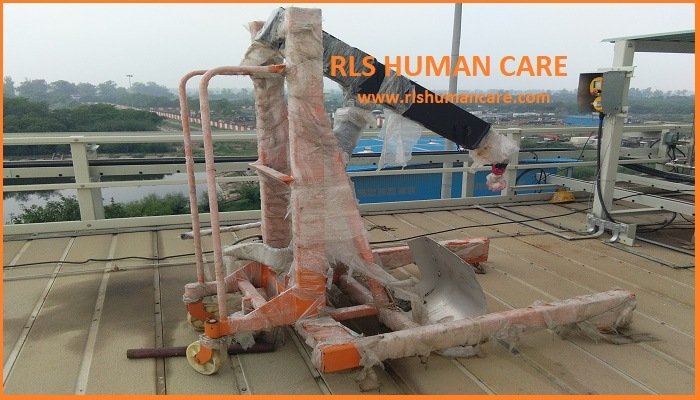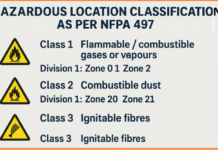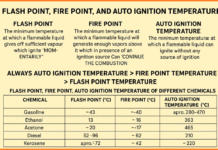Contents
Objectives of material handling
Manual Material Handling is the preparation, placing and positioning of material to facilitate their movement or storage. In many industries, handling of materials, articles, equipment, etc. become Less a main source of injury.
Importance of material handling
Without handling any materials, no production is possible.
Statutory Provisions for Maximum Liftable Load by Manual Handling
Rule 62 of the Gujarat Factory Rules pre the following maximum loads that could be manually carried or lifted.
MANUAL HANDLING
| Person | Permissible Max. Weight (Kg) |
| Adult male | 50 |
| Adult female | 30 |
| Adolescent male | 30 |
| Adolescent female | 20 |
| Male child | 16 |
| Female child | 13 |
| Two adult workers working together | 500 |
Rule 38 of the Building and Construction Workers Central Rules, 1998 also prescribes the same limits for building workers.
It is also clarified that no adult male, adult woman, adolescent or child shall engage, in conjunction with others in lifting, carrying or moving by hand or on the head, any material, article, tool or appliance if the weight thereof exceeds the lowest weight fixed by the above table for any of the persons engaged multiplied by the number of persons engaged. Thus two male children cannot be engaged to lift more than 16 × 2 = 32Kg, five adolescent females cannot be engaged to lift more than 20 × 5 = 100Kg and so ordination losses.
However, it is true that looking to a variety of differences in persons of the same age and same-sex, they differ in their capabilities. Personal and climatic factors also have the effect (e.g. heat stress, cold stress, discomfort, etc) on them of the same age and sex, different persons can lift different amounts of weight because of their body built, practice, height, weight structure, etc. Workload condition, shape, size (job safety analysis) and personal health should also be considered in deciding lifting standards.
Nevertheless, from safety and legal point of view, it is necessary to prescribe some reasonable safe limits based on scientific criteria. Otherwise, the exploitation of workers requiring them to lift any amount of load is possible. This may result in accidents, injuries, absenteeism and leaving the job.
Standards for Manual Handling
Leather for leg guards IS 3946, for garments IS 12718, leather shoes, non-slip, oil-resistant rubber soles IS 11543, leg and foot safety equipment selection IS 6519, 10667. Gloves disposable IS 7180, chrome leather IS 5866, leather gauntlets and mittens 2573, rubber-surgical IS 4148, Safety industrial gloves IS 6994, insulating materials for live working IS 13774, Electrical purpose rubber gloves IS 4770, Rubber aprons 4501, Safety equipment for arms and hands IS 8807.
Guide for selection of body protection IS 8519, Safety belt and harness IS 3521, Protective leather clothing IS 6153, Eye protectors IS 5983, Face shield IS 8521, Leather safety boots and shoes IS 1989, Protective gaiters IS 2472, Footwear for steel plant IS 10348, PVC boots IS 13038, IS 13292.
Safety helmet IS CODE 2925, Respirators glossary IS 8347 selection, use and maintenance IS 9623. Breathing apparatus IS 10245, Life jackets IS 6685.
In manual material handling human body acts as a machine (lever mechanism) and undergoes forces and torque. Therefore stress and strain occur and if work goes beyond one’s capacity, pain, fatigue or injury results.
Types of adverse effects or injuries associated with manual material handling are a strain, sprain, back pain, cuts, bruises, burns, fracture and non-traumatic injuries occurring after a long time.
Therefore it needs to understand the kinetics of manual material handling Lifting and carrying exert strains to the body. The body can be kept erect only by tensing muscles. Even while walking on slopes or stairs, considerable effort is required.
Carrying load imposes a static strain on muscles of arms and trunk and also on back and heart. Muscles are also engaged while holding the load and cause fatigue. Serious fatigue results in reduced output and may cause an accident.
Clinical investigations carried out by Schroter on groups of manual handling workers and office workers shown the effect on the skeletal system such as in the spine elbow joints, knee joints, etc. While lifting load lumber discs are affected much.
The lifting system of the spine can be represented as a double-armed lever arrangement in which the force of the back muscles is applied to the ends of the spinous process, which are about 5 cm long.
According to the principles of levers, the force exerted by the back muscles must be 8 or more times the resistance represented by the load. The strain is borne by the disc exceeds that exerted by the back muscles by an amount equal to the weight of the load. It has been noticed that on men between 20 to 30 years, disc stress of over 30 kg/cm2 can be damaging.
Lifting lighter loads with jerks is also harmful and may cause spinal pain.
Lifting and Carrying of Different Objects:
Their methods are briefly as follows:
- Boxes and Carton: Grasp them at opposite top and bottom corners. Draw a corner between legs.
- Barrels and Drums: Two men stand on the opposite side. Grasp both chimes near the high point-up and while pressing down the bottom and straighten up with the drum. Handling on the incline – Use ropes and tackles. To control motion, pass a rope around a drum. One end of the rope should be fastened to the platform at a higher level. A worker keeps a firm grip on the free end, then gradually lower or raise the drum along with the risers.
- Sheet Metal: Handle with leather gloves, hand leathers or gloves with metal inserts because of sharp edges and corners.
- Sheet Glass: Handle with gloves or hand leather. Cover wrists and forearms with long leather sleeves. Leathers or canvas apron and guards for feet and ankles should be worn. Carry the glass sheet with the bottom edge resting in a palm turned outward and with the other hand holding the top edge to steady it or balance it. Never carry glass sheet under the arm because fall might sever an artery.
- Long Objects: Long pipes, bar stock, Humber should be carried over the shoulders, with the front end held as high as possible to prevent striking. other employees should guide when going around corners.
- Irregular object: If it is difficult to handle because of its shape or weight, assistance should be given.
- Metal Scrap: Wear PPE like goggles, gloves or hand leathers, safety shoes and skin guards. Workers should be cautioned against tripping or slipping on objects which may roll or slide under feet Mechanical handling or this commodity (magnetic lift crane) is preferable.
Heavy machines, round, flat object, etc. need specially trained workers. Specially designed truck, trolly or device is required.
Safe Use of Accessories for Manual Handling
Each tool or other devices should be kept in good repair and used for the job for which it is designed.
- Hooks: Danger of glancing off the hard object. When carried in a belt, the point should be covered. Sharp point necessary for handling bags, logs, crates, boxes, etc. Should be protected.
- Crow Bar: The Main hazard is slipping. Point or edge should have a good bite. Proper position of hand and body to minimize chances of hand pinching or worker falling if the bar slips. Never work astride a crowbar. When not in use, keep on a rack.
- Rollers: Heavy or bulky objects are often involved in the rollers. The main hazard is fingers or toes getting pinched or crushed between the roller and the floor or the roller and the object when the direction of the roller is changed. To move a roller under load, use a sled or a bar, never hand or foot.
- Hand truck and wheelbarrow: It has mostly 4 or more wheels.
- Knuckle guards to protect jamming of hands against the door frames or other obstructions.
- The wheel should be under the truck if possible to save injuries to toes and feet. Wheel guards are preferable.
- Provide brakes to avoid holding a truck with a foot on wheel or axle.
- Inspect daily and keep in good repair.
- No one truck is right for handling all types of material. Select the appropriate one.
- Loaders should keep their feet clear of wheels. The load should be so placed that it will not shift, fall off or block clear view ahead.
- On two-wheelers, the center of gravity of load should be placed well forward.
- Four-wheelers should be pushed and not pulled.
- Avoid collision especially at blind corners. Use a mirror at the corner.
- Do not park trucks in aisle ways so as to obstruct traffic or causing stumbling hazards.
5. Hand Trolley: It has mostly 3 to 4 wheels
- Cover floor holes or remove bumps and make it even to prevent trolly from jumping.
- Provide rubber tires on wheels to minimize noise and damage to flooring.
- The load should be evenly distributed to prevent tilting.
- Don’t overload trolleys. It is unsafe.
- Load height on trolley should not obstruct vision.
- Secure load on trolleys with ropes, stay blocks, etc. wherever necessary.
- While going up on the slope, pull up the trolley and while going down on the slope push down the trolley.
- Trolley handles should be held at the front and not on the sides to avoid knuckles getting bruised due to contact with wall or machine etc. If the trolly handles are to be held on sides, provide knuckle guard.
- Pathways should be clearly marked in white or colored lines.
- Park trolleys in such a way that they do not obstruct passageways.
6. Jack: An identifying plate showing lifting capacity should be visible. It should be painted or marked on it and never be exceeded. If hydraulic fluid leaks, that Jack should be removed from use. Jacks should be lubricated only at points required, They should not be thrown or dropped. The resting floor should be checked for load-bearing capacity and level. A hard wool insert should be used between the jack head and the load to avoid metal to metal contact. After the load is raised, metal or heavy wooden stands should be placed under it for support and risk of jack slipping or falling. To raise a large-sized load, two or more jacks should be used, but they should be equally raised. Workers should wear safety shoes. Oil spillage should be cleaned before and after the work.
IF YOU LIKE THIS ARTICLE “MANUAL HANDLING” PLEASE SHARE WITH YOUR FRIENDS.








Good article for manual handling ,this also elightened the employees